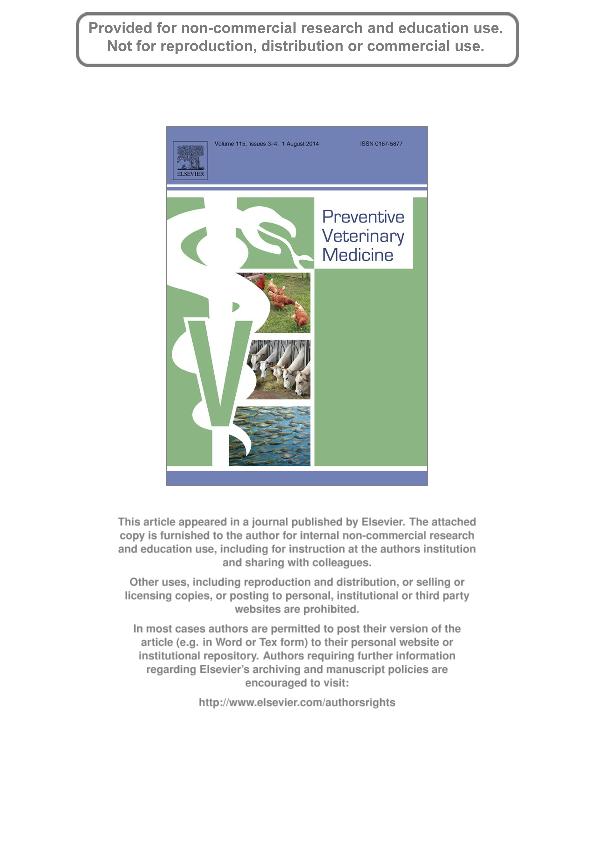Mostrar el registro sencillo del ítem
dc.contributor.author
Giacobino, Agostina

dc.contributor.author
Bulacio Cagnolo, Natalia Verónica

dc.contributor.author
Merke, Julieta

dc.contributor.author
Orellano, Elena Graciela

dc.contributor.author
Bertozzi, Ezequiel

dc.contributor.author
Masciangelo, G.
dc.contributor.author
Pietronave, H.
dc.contributor.author
Salto, C.
dc.contributor.author
Signorini Porchietto, Marcelo Lisandro

dc.date.available
2017-12-21T19:37:38Z
dc.date.issued
2014-04
dc.identifier.citation
Signorini Porchietto, Marcelo Lisandro; Salto, C.; Pietronave, H.; Masciangelo, G.; Bertozzi, Ezequiel; Orellano, Elena Graciela; et al.; Risk factors associated with the presence of Varroa destructor in honey bee colonies from east-central Argentina; Elsevier; Preventive Veterinary Medicine; 115; 3-4; 4-2014; 280-287
dc.identifier.issn
0167-5877
dc.identifier.uri
http://hdl.handle.net/11336/31259
dc.description.abstract
Varroa destructor is considered one of the major threats for worldwide apiculture. Damage caused by varroa mite includes body weight loss, malformation and weakening of the bees. It was also suggested as the main cause associated with colony winter mortality and as an important vector for several honey bee viruses. Little is known about multiple factors and their interaction affecting V. destructor prevalence in apiaries from South America. The aim of this study was to identify risk factors associated with V. destructor prevalence in east-central Argentina. Parasitic mite infestation level and colony strength measures were evaluated in 63 apiaries distributed in 4 different regions in east-central Argentina in a cross sectional study. Data regarding management practices in each apiary were collected by means of a questionnaire. A mixed-effects logistic regression model was constructed to associate management variables with the risk of achieving mite infestation higher than 3%. Colonies owned by beekeepers who indicated that they did not monitor colonies after mite treatment (OR = 2.305; 95% CI: 0.944–5.629) nor disinfect hives woodenware material (OR = 2.722; 95% CI: 1.380–5.565) were associated with an increased risk of presenting high intensity infestation with V. destructor (>3%). On the other hand, beekeepers who reported replacing more than 50% of the queens in their operation (OR = 0.305; 95% CI: 0.107–0.872), feeding colonies protein substitute containing natural pollen (OR = 0.348; 95% CI: 0.129–0.941) and feeding colonies High Fructose Corn Syrup (HFCS) (OR = 0.108; 95% CI: 0.032–0.364), had colonies that were less likely to have V. destructor infestations above 3%, than beekeepers who did not report using these management practices. Further research should be conducted considering that certain management practices were associated to mite infestation level in order to improve the sanitary condition in the colonies. Epidemiological studies provide key information to design surveillance programs against one the major threat to worldwide beekeeping.
dc.format
application/pdf
dc.language.iso
eng
dc.publisher
Elsevier

dc.rights
info:eu-repo/semantics/openAccess
dc.rights.uri
https://creativecommons.org/licenses/by-nc-sa/2.5/ar/
dc.subject
Risk Factors
dc.subject
Varroa Destructor
dc.subject
Apis Mellifera
dc.subject
Management Practices
dc.subject.classification
Otras Ciencias Veterinarias

dc.subject.classification
Ciencias Veterinarias

dc.subject.classification
CIENCIAS AGRÍCOLAS

dc.title
Risk factors associated with the presence of Varroa destructor in honey bee colonies from east-central Argentina
dc.type
info:eu-repo/semantics/article
dc.type
info:ar-repo/semantics/artículo
dc.type
info:eu-repo/semantics/publishedVersion
dc.date.updated
2017-12-21T14:07:32Z
dc.journal.volume
115
dc.journal.number
3-4
dc.journal.pagination
280-287
dc.journal.pais
Países Bajos

dc.journal.ciudad
Ámsterdam
dc.description.fil
Fil: Giacobino, Agostina. Consejo Nacional de Investigaciones Científicas y Técnicas. Centro Científico Tecnológico Conicet - Santa Fe; Argentina. Instituto Nacional de Tecnología Agropecuaria. Centro Regional Santa Fe. Estación Experimental Agropecuaria Rafaela; Argentina
dc.description.fil
Fil: Bulacio Cagnolo, Natalia Verónica. Instituto Nacional de Tecnología Agropecuaria. Centro Regional Santa Fe. Estación Experimental Agropecuaria Rafaela; Argentina
dc.description.fil
Fil: Merke, Julieta. Instituto Nacional de Tecnología Agropecuaria. Centro Regional Santa Fe. Estación Experimental Agropecuaria Rafaela; Argentina
dc.description.fil
Fil: Orellano, Elena Graciela. Instituto Nacional de Tecnología Agropecuaria. Centro Regional Santa Fe. Estación Experimental Agropecuaria Rafaela; Argentina
dc.description.fil
Fil: Bertozzi, Ezequiel. Instituto Nacional de Tecnología Agropecuaria. Centro Regional Santa Fe. Estación Experimental Agropecuaria Rafaela; Argentina
dc.description.fil
Fil: Masciangelo, G.. Instituto Nacional de Tecnología Agropecuaria. Centro Regional Santa Fe. Estación Experimental Agropecuaria Rafaela; Argentina
dc.description.fil
Fil: Pietronave, H.. Instituto Nacional de Tecnología Agropecuaria. Centro Regional Santa Fe. Estación Experimental Agropecuaria Rafaela; Argentina
dc.description.fil
Fil: Salto, C.. Instituto Nacional de Tecnología Agropecuaria. Centro Regional Santa Fe. Estación Experimental Agropecuaria Rafaela; Argentina
dc.description.fil
Fil: Signorini Porchietto, Marcelo Lisandro. Instituto Nacional de Tecnología Agropecuaria. Centro Regional Santa Fe. Estación Experimental Agropecuaria Rafaela; Argentina. Consejo Nacional de Investigaciones Científicas y Técnicas. Centro Científico Tecnológico Conicet - Santa Fe; Argentina
dc.journal.title
Preventive Veterinary Medicine

dc.relation.alternativeid
info:eu-repo/semantics/altIdentifier/doi/http://dx.doi.org/10.1016/j.prevetmed.2014.04.002
dc.relation.alternativeid
info:eu-repo/semantics/altIdentifier/url/http://www.sciencedirect.com/science/article/pii/S0167587714001421
Archivos asociados
